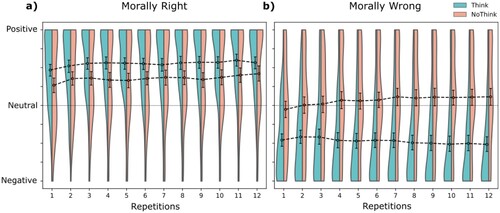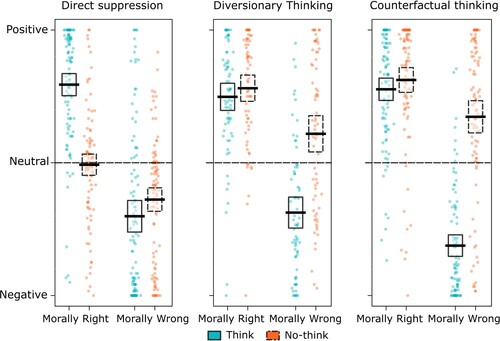Figures & data
Figure 1. Illustration of the procedure and trial structure of key phases in the experiment. Participants attempted to control memories associated to red (No-Think) cues, and consciously recollect associated memories to green (Think) cues. Different groups of participants used different memory control strategies (direct suppression, diversionary thinking, or counterfactual thinking). Participants indicated how they felt in each trial using the “1 2 3” emotion rating scale.

Table 1. Pre-TNT Ratings: Differences between morally right and wrong memory characteristics measured during the generation phase collapsed across all three memory control strategy groups. Pre vs. Post-TNT Ratings: Changes in phenomenological and emotional characteristics from before to after the Think/No-Think task for morally wrong versus right memory types. The table shows the mean pre vs. post-TNT task difference scores and the main effect of memory type on those scores (collapsed across memory control strategy and Think/No-Think instruction).
Figure 2. Average emotion ratings during the Think/No-Think task trials, compared across Think and No-Think conditions and 12 presentations of cues for a) morally right and b) morally wrong memories. The data is collapsed across strategy group. The split-violin plots illustrate the distribution of online emotion ratings for each condition. The error-bars depict bootstrapped 95% confidence interval. N = 135.

Figure 3. Average emotion ratings in the Think/No-Think task, compared across moral Memory Type and Think/No-Think condition, for each Strategy Group. Diversionary thinking and counterfactual thinking improved feelings for both memory types, but direct suppression improved negative feelings for morally wrong memories, but dampened positive feelings for morally right memories. The y-axis depicts the online rating scale which ranges from -1 (Negative), 0 (Neutral), to +1 (Positive). Scatter dots show the mean emotion rating for a condition of each individual participant. The thick lines show the condition means and the boxes depict the 95% confidence interval of the means. N = 135.

Table 2. Results of an omnibus ANOVA testing for differences in the online emotion measure (collected during the Think/No-Think task) due to experimental manipulations, collapsed across repetitions.
Satish Hellerstedt Anderson Bergstrom Control Strategies Supplementary File FINAL.docx
Download MS Word (24.1 KB)Data availability statement
The data and analysis code that support the findings of this study are openly available in the Open Science Framework, an open science platform. Please use this link to access this material on OSF: https://osf.io/gyk38/. This link is set to view-only for the peer-review process and will be fully accessible after publication.
